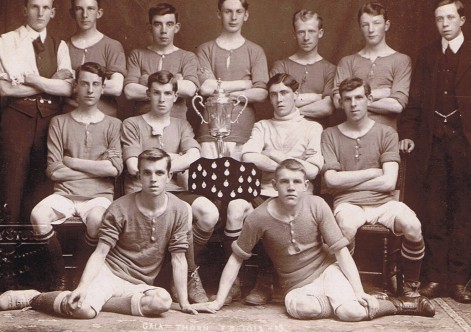A Scion Society of The Baker Street Irregulars

December HolmeWork Assignment: Conan Doyle and the Mystery of the Vanishing Football Cup
Editor’s Note: The following story appeared in the November 11, 2011 issue of the Scottish newspaper The Southern Reporter. While the story focuses on a missing football trophy, I picked up the reference to the medals in the story. Has anyone seen these medals from the Doyle Cup for 1912-13 or for, that matter, any other year?
* * * * * * *
Sherlock Holmes creator Sir Arthur Conan Doyle presented a cup to a Borders football club early in the last century – and the discovery leaves a mystery, appropriately, unsolved.
The story of the cup was discovered, as far as it goes, by a Newcastle woman compiling her family tree. Now, she is hoping that amateur Borders historians can help her sleuth out more details.
Grace Lee, whose relatives on her father’s side, the Mann family, come from Galashiels, has been trying to find out about two old photographs, one of which shows her grandfather and his brother.
Her grandfather, George Mann and his brother, John, played for Gala Thorn Football Club in the years just before the First World War.

One of the pictures intriguing Mrs Lee shows George and John Mann and their Gala Thorn team-mates in the 1912-13 football season.
The other photograph is of a silver medal. Mrs. Lee has two of these solid silver medals, each inscribed on the reverse with “Doyle Cup 1912-13”, and bearing the names of her grandfather and great-uncle.
She told TheSouthern: “I am particularly interested in knowing any background to the club – how long it was in existence, who they played and when they won the cup.
“I contacted the Border Football League but they haven’t been able to supply any information. So I was wondering if any readers would be able to help or to suggest who else I might contact.”
A little research on the internet turned up the information that the Doyle Cup – or Conan Doyle Cup as it was properly termed – was first competed for in 1905.
Mrs. Lee’s suspicion that it had possibly been presented by Sherlock Holmes creator, Sir Arthur Conan Doyle, proved correct. The famous writer had donated the trophy to the Border Amateur League, and became one of the organisation’s patrons.
In 1906, Conan Doyle stood as a Unionist candidate for Westminster in the Hawick Burghs constituency, which included Galashiels, though he failed to unseat the sitting MP, Thomas Shaw.
Some websites say the whereabouts of the trophy is not known, but it is believed to have been gifted during the war, like other junior trophies at the time, as a prize for tournaments between regiments.
This information must refer to the Second World War as it is recorded that Kelso United Football Club lifted the Conan Doyle Cup during season 1937-38.
Mrs Lee says she has collated plenty of information as regards family members, stretching back to the mid-1700s, but she would really like to find out more about the football team and the trophy.
“What I don’t know is whether these medals were awarded for winning the cup or were for being the runners-up. It would seem strange, though, to present hallmarked solid silver medals for being runners-up,” she said.
As far as Gala Thorn FC is concerned, Mrs Lee has only managed to discover that the club was still functioning in the 1920s.
“No-one seems to known anything about this club, so if any of TheSouthern’s readers could shed any light on the club, or provide more information on the Doyle Cup and its whereabouts now, that would be absolutely fantastic,” she said.
Mrs Lee’s parents were the late James and Edith (nee Stoddart) Mann, who moved from Galashiels to Lanarkshire in 1955. Before that, the Manns were long established in Galashiels and many members of the family worked in the town’s woollen mills.
Mrs Lee’s grandfather, George Mann, survived the carnage of the First World War, but John was killed in Flanders in 1918.
The article, at least online, does not include a picture of the medal. Anyone willing to research this further?


Sorry, comments are closed for this post.